Are You A Vanguard? Applications Now Open
AP Photo/Carlos Osorio
This is your first of three free stories this month. Become a free or sustaining member to read unlimited articles, webinars and ebooks.
Become A MemberThere is a photo of the Flint River Rebecca Fedewa particularly likes. As the director of the Flint River Watershed Coalition, she has hundreds she can look at, and she does, but this one is special. It features people in kayaks and inner tubes floating around a wooded bend in the waterway, gathered together in summer 2015 to take part in the annual Flint River Flotilla. The lazy ride starts downtown and meanders through a well-known concrete channel by the former Chevrolet manufacturing site, dubbed “Chevy in the Hole,” and out into the countryside where, among acres of woods, you might just spot one of two resident bald eagles.
This is how Fedewa thinks of the river but, more importantly, and more desperately, it’s how she wants residents of the Flint region to think of the river — as 142 miles of vital public space and recreation. It’s been her mission since she started with the nonprofit FRWC as a volunteer in 2006, and when she took the director job in 2009, she knew there was still plenty of work to do.
There was that concrete section, symbolic of all those years before the 1972 Clean Water Act’s measures started restoring the health of America’s urban rivers, when General Motors dumped untold amounts of waste into the river, polluting it so badly there are those who say they remember years when, in the dead of winter, it wouldn’t even freeze. There were the stereotypes. The river is dirty. The river is polluted. There are bodies in there. Do not go in the river.
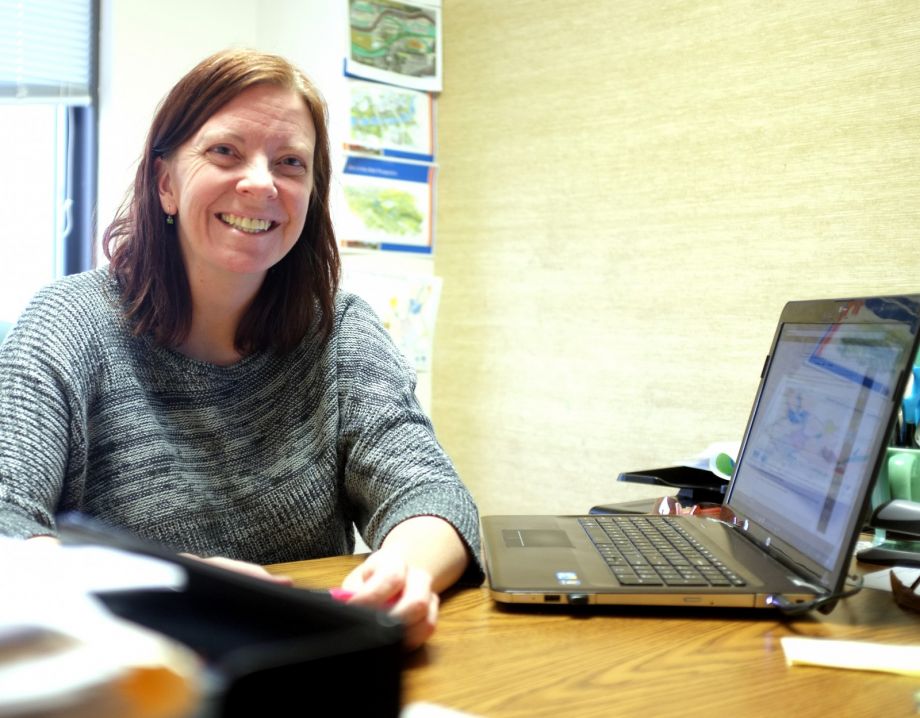
Rebecca Fedewa, executive director of the Flint River Watershed Coalition
Changing minds is hard of course, especially when making fun of a river can be, well, kind of fun. Something to laugh about, a strange point of pride in a city where there’s no shortage of things to complain about.
Fedewa did see progress. There was the annual flotilla, and a new Flint master plan that identified the river as an important component of the city’s future economic and social health.
But as she chipped away at the old stereotypes, she had no idea that she’d eventually be defending the river amid a storm of poisoned tap water, and charges of environmental racism and failed leadership. She didn’t know the residents of her city would come to have a very good reason to be suspicious of anyone official looking telling them “the water’s fine.”
In 2013, Flint started a process to temporarily tap its river for drinking water while awaiting the completion of a new pipeline that would bring a direct supply from Lake Huron. River enthusiasts saw the move as potentially helpful to their cause. The city had used Flint River as a drinking source before. (It began buying water from Detroit, about 70 miles to the south, in 1967 because the river couldn’t meet the demand for a then-growing industrial city.) Fedewa and company thought the stopgap might prove to 21st-century residents, once and for all, that the river was safe — that you could fish it, kayak it … and yes, even drink it, so long as it was treated properly.
Instead, almost immediately after the city started pumping the Flint River in April 2014, residents had concerns about quality and safety. They said their tap water tasted strange or was discolored. Then there were boil advisories, due to E. Coli in the water, but many officials continued to say the water was safe to drink. By 2015, researchers, residents and at least one local physician were calling attention to elevated lead levels in the tap water and in children. Finally, last October, state officials admitted to the presence of lead, a dangerous neurotoxin that can irreparably harm the developing brains of children. (Flint switched back to the Detroit water supply that same month.)Several government agencies are still investigating the public health crisis and accountability is being sorted, but the source of those high lead levels has been determined: a failure to follow federal guidelines to treat the river water. Phosphates were not added, a process that creates a protective layer in pipes to keep the more corrosive river water from eating away at them. This treatment failure meant that lead from the post-industrial city’s dated service lines leached into the water as it was routed to citizens’ taps.
As the severe nature of the health emergency made headlines around the U.S., the Flint River, much to Fedewa’s dismay, was cast as a central villain. More than the failure to follow federal treatment guidelines, more than the state officials who for a year-plus had been telling Flint residents their drinking water was safe.
“We had high hopes,” she says, “that they would get this right and that people would say, ‘Wow, this river is amazing.’”
Instead, as the crisis unfolded (residents continue to live in a state of emergency), she says she heard about someone asking, straight-faced, if their kayak paddles would melt in the river.
As many residents of Flint have worked relentlessly to bring necessary attention to the dangerous tap water and demand appropriate government response, Fedewa and colleagues have refused to give up on the river’s potential as a valued asset. Even with the fresh set of challenges to the river’s reputation, Fedewa is looking at an upside: People are at least paying attention to the river.
Getting attention to problematic places along rivers, in fact, is something that Brian Davis says can actually lead to positive outcomes and opportunities. Davis is a professor in the department of landscape architecture at Cornell University and specializes in urban river systems and how they can be “stitched back into the cultural context of the city.” He says areas of concern to the EPA are more ripe for federal funding to get them cleaned up — and while funds are often exclusively intended for cleanup efforts, there is often some leeway in how it all gets spent. Cleaning an area up often means silt removal and construction, “but because it’s part of the city,” he says, “it needs to perform multiple functions.” That could mean parks or other kinds of public development get lumped into larger environmental remediation projects, which can also lead to other benefits.
“If it’s an area that’s dangerous you’re going to be putting up a fence around it or something,” Davis says. “If it’s clean it becomes a lot more palatable to politicians or investors who say, ‘I want to put a restaurant there,’ or ‘we should put a walkway through there.’”
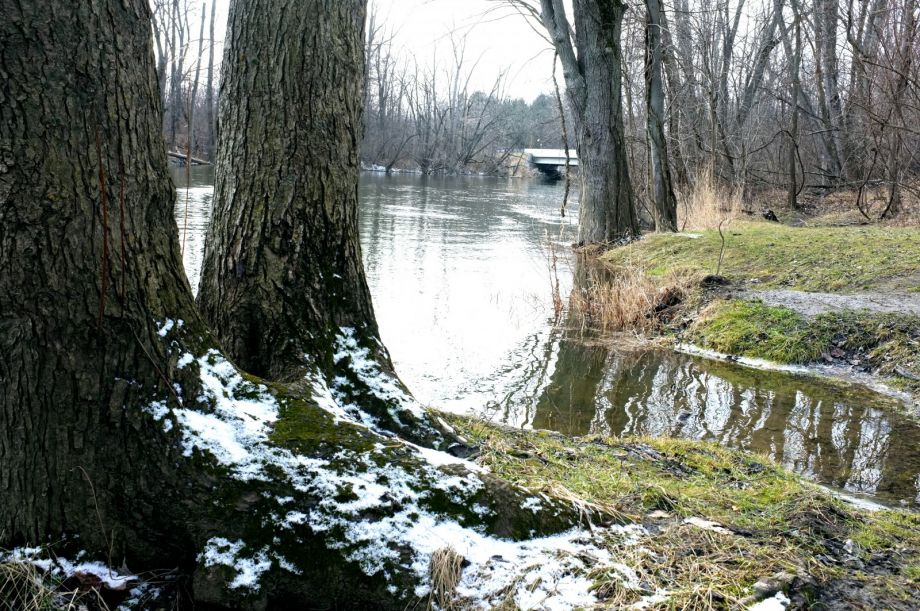
The Flint River spans 142 miles.
The potential he describes fits with Flint’s vision according to its 2013 Master Plan, the city’s first update in more than 50 years.
“Imagine the Flint River revitalized for economic growth and recreation, brimming with kayakers and canoers, and home to a vibrant ‘green waterfront’ of parks and trails spanning the entire length of the river,” the master plan reads.
When adopted, the updated plan was seen as a huge step forward for a city struggling to take steps forward, and U.S. Rep. Dan Kildee, who represents Flint in Congress, says that’s something he’s ready to see local attention return to.
“I think Flint needs to quickly return to the path we were on before the crisis in terms of rebuilding itself and redesigning the city,” he says. “One of the things that includes is the Flint River as it goes through downtown Flint.”
Dayne Walling was the mayor when the master plan was implemented and says projects involving the Flint River were part of a larger effort for the city to adjust to its smaller population and to the 21st century. In addition to the master plan, the city began implementing annual capital improvement plans, which involved naturalization and beautification to city parks and the construction of a “rain garden” on the city’s east side. In early 2015, work started to transform Chevy in the Hole, currently a quarter mile of concrete and gravel along the river downtown, into Chevy Commons, a central park and nature area.
While delivering safe drinking water is of paramount importance over the beautification of a river or the number of people kayaking it, Walling thinks the waterway still has an important role in overcoming Flint’s woes, which in addition to the water crisis, include a depressed economy and a shrinking population.
“A number of the objectives [in the master plan] specifically mention the Flint River because it’s so central to the city’s development, and unfortunately we’re now in a new era where the river is being seen as a major part of the problem with the city’s water supply. And those complications are going to take a generation to overcome,” Walling says. “So the immediate public health and infrastructure issues have to be the first priority, but the broader recovery has to include the environment and economic factors so the end result is a truly sustainable community.”
Revitalizing an urban river comes with many challenges — coordinating multiple agencies, mitigating pollution, designing an equitable development plan that creates renewed public space and economic opportunity for all residents. But a community’s embrace of its main waterway can go a long way toward achieving success.
In January, Fedewa sat in her office, watching the headlines. The national media had descended in full force, and while some were doing good work, there were things she couldn’t believe she was reading.
“A lot of the press is focusing in on whose decision was it to move to the Flint River. … The decision to not treat the water adequately was the beginning of this entire debacle,” she says.
And while those in power should be held accountable (a former aide of Governor Rick Snyder recently told the Detroit Free Press, “the people of Flint got stuck on the losing end of decisions driven by spreadsheets instead of water quality and public health”), there is an undercurrent she can’t stand, a misunderstanding about the river made all the stronger because it is not implicitly stated, but buried within sentences.
The word “corrosive,” for example, while true in a sense, can be misleading because, Fedewa says, the Flint River is as corrosive as any healthy river. One of the researchers who first identified the high lead levels in the tap water told the Detroit Free Press in January, “We looked at the river very carefully. I didn’t see anything that proper treatment couldn’t render potable.” Rivers do have higher levels of things like chloride, which can be a cause of corrosiveness — but that’s the kind of thing experts know, or at least should know. It’s the reason federal guidelines call for the use of phosphates.
The river’s been called other things like caustic or toxic, “sometimes ‘really toxic,’” Fedewa says. CNN referred to the river as “a notorious tributary that runs through town known to locals for its filth.” Flint native Michael Moore said the public had to drink “from the toxic Flint River.”
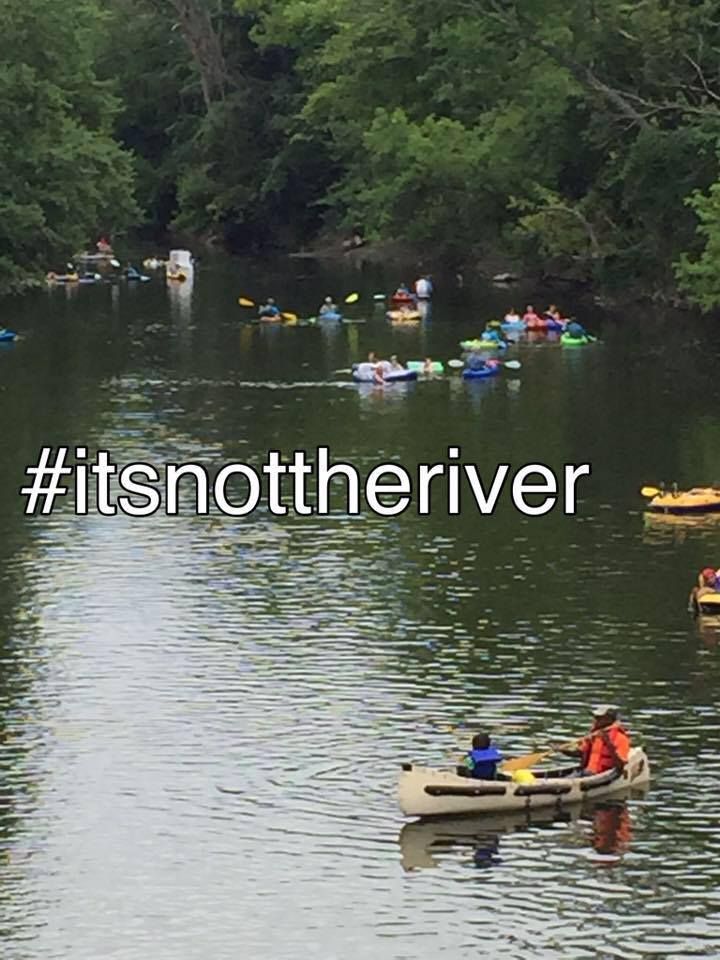
Since Fedewa posted this image to her Facebook page, many others have posted their own photos of the Flint River with the #itsnottheriver hashtag across them.
On Jan. 14 she couldn’t take it anymore. “I’ve written and deleted at least a dozen posts about how pissed off I am about this water situation in Flint. I can no longer contain my anger,” she wrote on Facebook. Part of her was aligned with the anger of every parent who was thinking about what a child’s exposure to the lead-laced water might mean. (Last fall, Fedewa was living in an old Flint home, pregnant with her now infant son; she has since moved out of the city.) She wrote about the failure of public officials.
She also begged people not to blame the river.
People responded. One suggested they start a hashtag and make T-shirts bearing it: #itsnottheriver. Fedewa skipped the T-shirts, but she did dig up that picture, the one of the flotilla (there was another one she wanted, of a little kid splashing in the water, but she didn’t have the parents’ permission), added the hashtag and threw it out into cyberspace. Then she continued to sit in her office, reading headlines, wondering if anyone would notice, or care.
The first site Jaime Welch, the FRWC education programs manager, visits is directly across the Flint River from the water treatment plant, not far from where the plant actually draws its water. It’s February, and if you were to hope to paint a bleak picture of Flint, and especially its river, this wouldn’t be a bad place to go. The old plant sits on the same grounds as the original plant, an almost gothic-looking building built in 1917, made of old red brick. Most of its windows are smashed out.
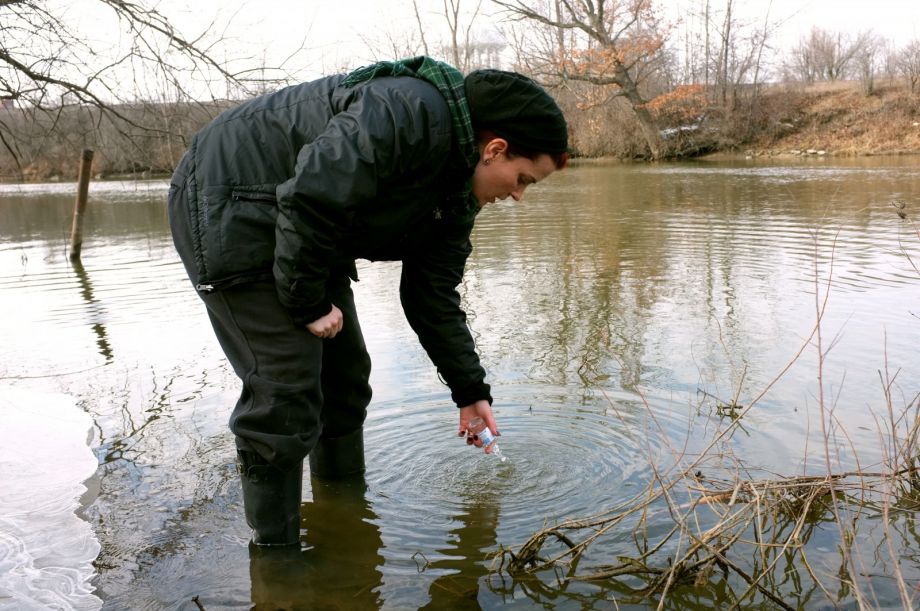
Jaime Welch, the education programs manager for FRWC, dips a bottle into the Flint River for testing near the Flint water treatment plant.
Welch parks her SUV in front of two giant logs that block a cracked asphalt driveway to the river; the water tower looms in the distance. The logs are there to prevent people from driving down to the water’s edge to dump garbage, but they’re only partially successful. One garbage bag sits just on the other side of one of the logs, partially open and revealing plastic bottles and old pipe tobacco bags, looking as though someone has already rifled through it.
This is the first stop on a weekly circuit for Welch. Wearing rubber boots, she takes a familiar trodden path by the water’s edge, where it’s too steep to mow, and begins taking samples. Like Fedewa, she loves the river, especially all its creatures and bugs — she’s in love with dragonflies.
“The one drawback,” she says, wading out and dipping one of her bottles into the river, “is I haven’t found a way to keep my hands from freezing yet.”
She takes the different samples and makes her way back to her SUV where she pops the back hatch and starts opening boxes revealing a chemistry nerd’s dream: vials and beakers and tiny glass bottles filled with chemicals for various tests. She runs through them mechanically, testing for things like turbidity (cloudiness), oxygen levels and chloride. The chloride is slightly higher than normal — not uncommon during winter months when road salt runs off into the watershed — but within safe range for both aquatic life and drinking water by federal standards. Other than that, all is normal. She’ll send samples of the water from here and all her stops to a lab in Lansing for independent testing.
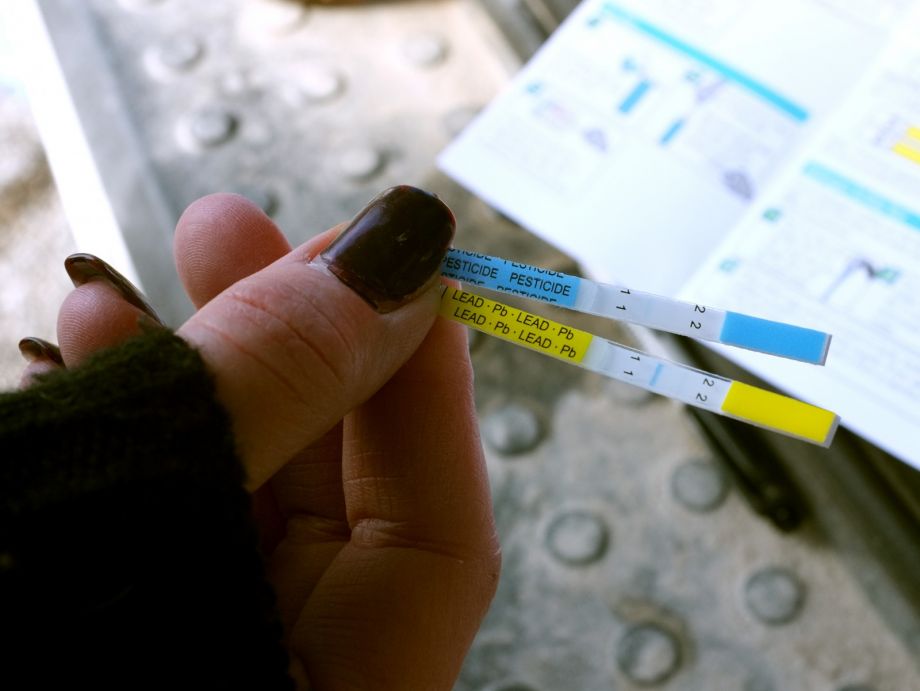
The FRWC has been testing the Flint River for lead to show that the river itself is not contaminated.
The last thing she tests for is lead. She never used to test for it, but once contamination of the drinking water was confirmed, she and Fedewa wanted to put minds at ease (or prove them wrong). It takes 10 minutes to come back negative, and she packs up her things and heads to the next site upstream.
It’s a boat launch site next to a county park with a BMX track. While she gets ready to wade into the water, Duane Reynolds, 52, and his son, Devon Witt, are launching their aluminum boat to go walleye fishing. Reynolds works the night shift and goes fishing on the river every morning.
Maybe closer to the city the water’s different, he says, but out here, in the woods, he’s not worried about it. “A lot of people are telling me they wouldn’t eat the fish out of here, but we’ve been eating it and we’re fine,” he tells me.
On Jan. 28, at Flint River Watershed Coalition’s big annual fundraiser, Fedewa stood at a podium in front of a room of people. She had numbers, facts, data gathered from all of Welch’s trips out to the river to prove that while things in the water pipelines were bad, Flint still had its river, perhaps its greatest natural resource.
A new Flint River exhibit served as a fitting background at the venue, the Sloan Museum, located in Flint’s cultural district. The show, two years in the planning, was initially supposed to be all about the river’s history and the future pipeline being built to connect Flint and Genesee County to Lake Huron. The $285 million project promises cheaper water (Flint residents pay as much as $200 a month for water) as well as local control over the drinking supply. As the story about the poisonous tap water made national headlines, curators added displays about the current crisis.Fedewa was in high spirits. Her hashtagged photo had been a hit. The last time she checked, another post promoting the river on FRWC’s site had almost 30,000 views, “which, for us, is beyond viral,” she says. They’d also run an advocacy campaign that included ads in the paper, and six billboards around Flint proclaiming the river as “142 miles of pure recreation.” She saw unfamiliar faces in the crowd, beyond the usual fundraiser suspects, there to listen to her talk about the river.
After presenting Welch’s test results, she moved onto other things they’ve been working on, the kinds of things they’d be talking about if they didn’t have to first prove that your kayak wouldn’t melt in the river.
Fedewa told the crowd about the National Water Trail designation they’re working on with the National Park Service to include the Flint River Trail, a 17-mile stretch popular among walkers and bikers in the community running from downtown into the countryside. She told them about the Riverfront Restoration Project to remove the Hamilton Dam sitting in disrepair, in the middle of downtown Flint. Years of work have allowed them to pay for the necessary engineering and planning to be done on how to remove it, and now it looks like the project may come to fruition. Once the dam’s finally removed and the area’s naturalized, it will allow, among other things, kayakers and boaters to paddle through the heart of downtown, waving to people who have never seen, or expected to see, anyone out there.
Our features are made possible with generous support from The Ford Foundation.

Scott Atkinson is a writer based in Flint, Michigan. His reporting on Flint has appeared in The New York Times, Rolling Stone, Belt Magazine and elsewhere. He teaches writing and journalism at the University of Michigan-Flint. You can view more of his work at scottatkinson.info.

20th Anniversary Solutions of the Year magazine